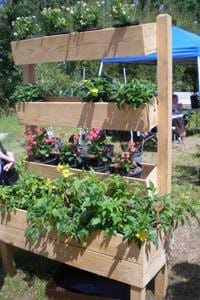In honor of National Horticultural Therapy Week (March 20th – 26th) we have asked Katrina Fairchild, a registered horticultural therapist (HTR), to share some thoughts on these types of gardens. Katrina writes:
Thinking back on my time of working with and developing a program for teenage at-risk students, I present you with a series questions to ask yourself when deciding to undertake this significant project of offering and developing horticultural therapy (or therapeutic horticulture).

What’s the primary purpose of offering the program and the garden?
Is it for profit? Social or emotional therapy? Educational opportunity, be it vocational or academic? Purposeful in terms of feeding local families in need, or teaching certain socioeconomic groups to eat healthier to keep certain diseases at bay? Simply aesthetic? This key question begins to address the size of the garden, its proximity (location), the people it serves, its longevity, community resources to assist you, and the big question of “how much will it cost?”
Do I have the time to dedicate to planning and running a whole year of gardening?
Who will help me keep the garden going when I have a class to teach? What happens in the summer? Will I need to do one-on-one supervising in the garden or as a group?
What’s involved in programming a school garden?
It’s not just planting veggies, herbs and flowers as the seasons arrive; it’s pre-planning what to buy, how much space to dedicate, the material used, finding available resources, the return on what goes in the ground (is there continuity, for example, like seed-saving that turns into yet another session/project), planting for the holidays, student’s birthdays, special causes, and educational opportunities, just to name a few.
Am I making it fun, interesting, stimulating?
It’s very important to make the whole or a part of the garden personal and relevant. It should reflect the kids’ personalities, age, character, and life. To avoid mental or physical disengagement, you may need to plan a special “personal” square plot versus group gardening. One student I had was only intrigued by goth, so we stuck with black pansies and tulips. Play their music (not yours) while gardening. Make it relevant now: for example, select seeds that germinate quickly, and bring in samples they can eat now. Make it tangible: buy seedlings instead of seeds.
What timing and program constraints must I consider to satisfy the kids with VAK learning modalities?
An hour’s worth of outdoor gardening may end up being three different projects to capture and hold the interest of those who are visual, auditory and/or kinesthetic. More programming means less time in the garden.
How can I make this less work for me?
Get them involved from the beginning! From concept to crop, it’s their place. Get them involved in the planning stages of cost, design, layout, building, selecting favorite or new plants, colors, garden art, and what to do with excess crop. Assign or let them pick jobs or lead roles. Ownership is key.
How can I get the parents and community involved (and funding coming)?
The program is only as good as its longevity and engagement. Post photos of the garden and gardeners on social media. Send press releases. Maintain an ongoing photo album of the garden and its gardeners that is readily viewed in the classroom as well as online.
Am I making all this too complicated and burdensome?
It can be…unless you keep it simple. Sometimes we get too excited and over-inspired by what can be. Remind yourself to stop and re-analyze often: most things can be simplified. This is true from the types of material used to build the garden to the selection of herbs and vegetable.
Katrina Fairchild, is a registered horticultural therapist (HTR), certified landscaped designer (APLD), GA Certified Plant Professional (GCPP), and avid gardener and nature lover. She can be reached at (678)314-9082 or via her website www.theflowerfly.com.
Thanks, Katrina, for the great information. For more information about National Horticultural Therapy Week visit American Horticultural Therapy Association.
Happy Gardening!
